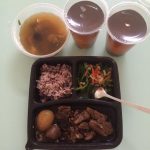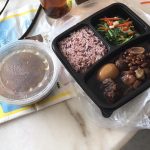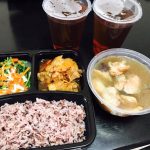81 Tagore Lane, TAG A, #01-11 Singapore 787502 ♦ Reservation : +65 6727 5599
Things to Consider When Planning Your Confinement Meals

If you have grown up in a traditional (or even semi-traditional) Asian household, you had probably noticed how some of your relatives would go through a period of recuperation after giving birth. During this period, they would stick to certain practices that you were probably not familiar with, such as layering their clothes and eating different kinds of foods.
Currently a new mom or mom-to-be yourself, you might have also gotten pieces of advice that go along the lines of ‘no showering’, ‘no stepping outside’, and even ‘no drinking cold drinks’. But…in this humid Singapore, too? Perhaps not.
So, what can you do instead? You can start by treating the set of ‘confinement rules’ as guidelines – rather than actual rules. Under no circumstances should you feel like you have to abide by everything the hundred years old tradition told you to. So many things have changed.
We have so many options and the technology has come so far that bathing with warm water does not require us to collect woods for boiling the bathwater. Given how far we’ve come, it is safe to say that these ‘confinement rules’ should also be allowed to be tweaked. On that note, it is important for you to know there are limitations in terms of what to eat and what not to eat as well.
Whether you are strictly following the traditional confinement practices or mix-and-matching things that you feel you can adapt to, it is important to ensure that your is at least, by your standards, appetising. If you end up not looking forward to your daily meals, that would only create a bigger problem in the future. On that note, here are things you’d need to take into account when it comes to planning your own daily confinement meals.
1. Getting raw meats and vegetables
In many cultures including Asian, fresh meat is considered better than frozen meat in many ways and to some extent, can have more positive effects on the consumer. If you hold on to this belief and at the same time following the traditional confinement way, you might face some difficulties to constantly get fresh ingredients while being confined to the house.
You can always count on your spouse or anyone else, but in the event that they won’t be around much, here’s what you can do. There are now many services and providers that can deliver groceries right to your doorstep. You can opt for this as a last resort. The only thing you have to do is to ensure that you are choosing the best service that fit what you are looking for.
2. Condiments
You are probably extremely familiar with condiments like ginger and what it does. In fact, ginger is possibly one of the top ingredients in confinement meals AND beverages. Without ginger, it isn’t confinement!
The thing about condiments is that despite their almost-invisible sizes among other ingredients in your meal, they play a huge role. In fact, the taste of a particular dish can depend entirely on the condiments you use for it. Therefore, as a hack, keep a huge stack of different kinds of condiments in case you happen to feel like spicing up your meals.
3. Proper Storage
Way, way back then, buying groceries online wasn’t a viable option. So, many moms have to freeze their foods. Now, you can get fresh groceries delivered right to your doorstep without you ever having to step outside!
That said, it is still as important that you keep the wet ones stored properly to not affect its quality or other foods. You can use disposable ziplock bags as well. Do remember to freeze your meals in correct portions for convenience in defrosting.
In the fridge, store your foods according to their types and make sure they do not touch each other. The three main types are:
1) Ready-to-eat (yoghurt, cooked meats, leftovers, and others)
2) Raw meat, poultry, and fish
3) Fruits and vegetables
4. One-Month Menu Plan
Planning your own confinement menu from scratch will ease the work of everyone in the house; you, your spouse, another family member, and domestic helper if you have any. Your spouse or your family member will know exactly what groceries to get, and your maid or anyone who cooks for you can learn your preferences better and adapt to it.
5. Calendar as Reference
This is heavily-linked to the previous point where we talk about creating a menu plan. Do make use of the calendar as a reference to help you with it, but not just in the regular way where you repeat certain foods on Thursdays and Saturdays. Match the days and activities you will do on that day. For example, if you plan to go on a postnatal yoga class on one of the Thursday, perhaps your body will need more energy on that day – hence, more carbs.
But wait — does this mean you will also have to plan your days for the whole confinement? Yes, but you do not think too far or too hard. Do not feel like this is now your book of rules that you should follow. Simply treating it like a set of guidelines would be more than enough. Eat what you feel like eating on most days. You might think ‘but then, how would that help me?’ It will help you on days when you do not know what to eat!
You May Also Read this : Benefits of Ingredients Used In Common Confinement Meals
While we are not here to topple age-old cultural practises, it is extremely crucial that you do what is suitable for you, and more importantly, what is sustainable in your dictionary. If you believe in the effectiveness of the traditional confinement diet, by all means, do follow it. Likewise, if you think DIY-ing your confinement will work better for you, you have all the help and options to make sure it’ll be a great one.
Overall, confinement meals preparation is not as complicated as it sounds. In fact, if you notice, some of the advice above applies to your everyday meals preparations, whether you are in confinement or not. The only part it might differ is that you are cutting out certain ingredients and adding in some others. Do view Tian Wei Signature’s menu to get the best help in planning Confinement food recipes Singapore moms like you need!







